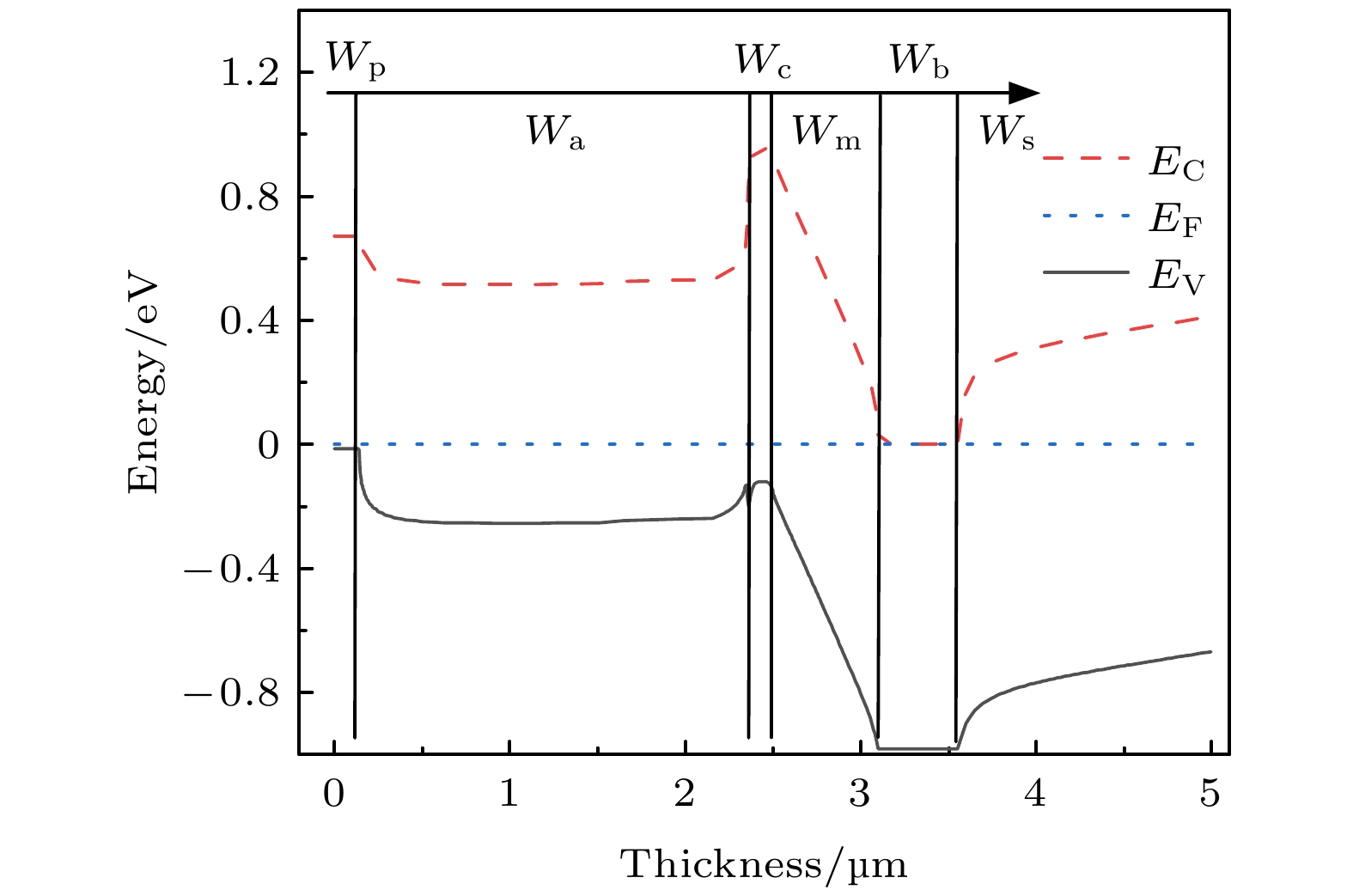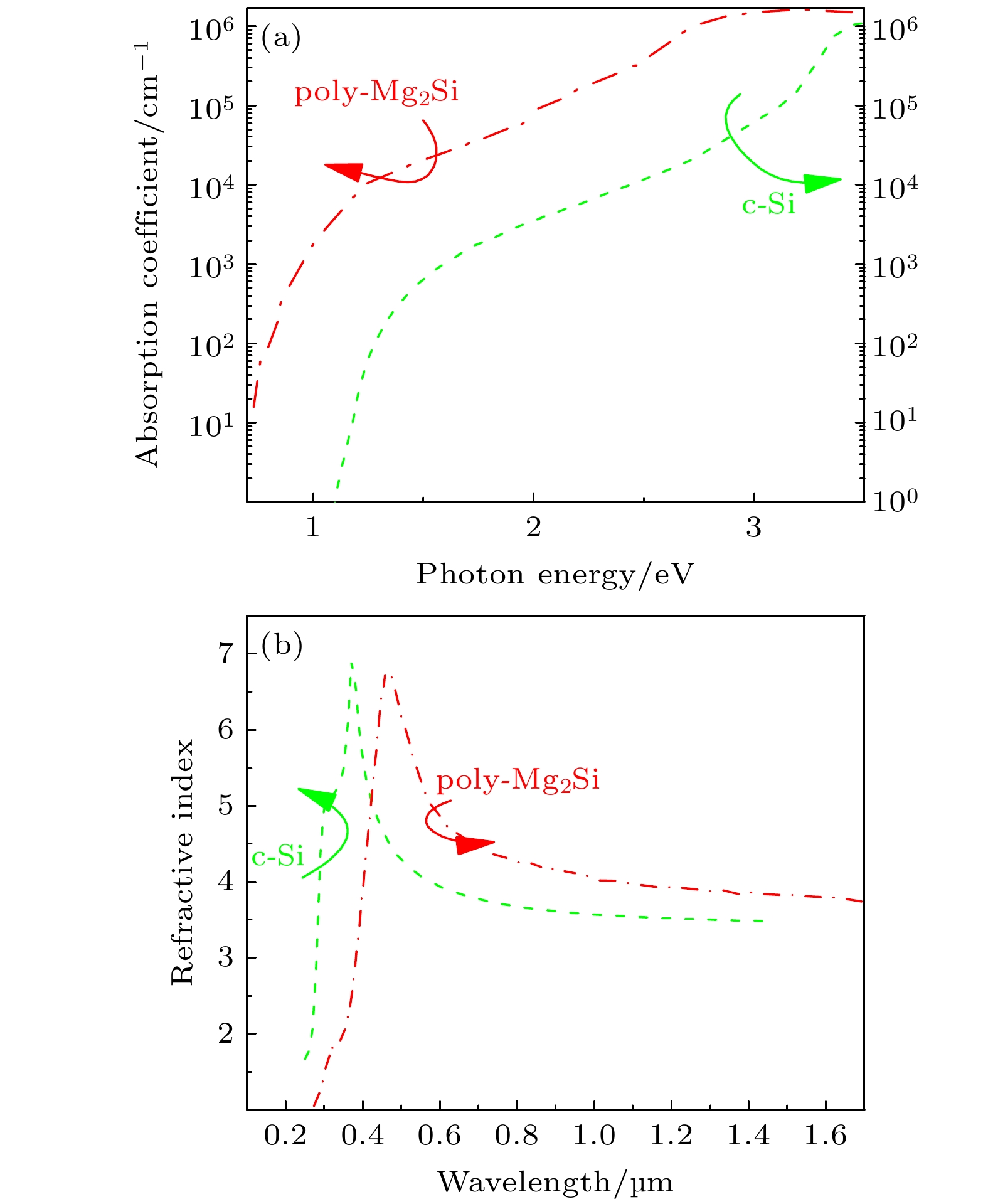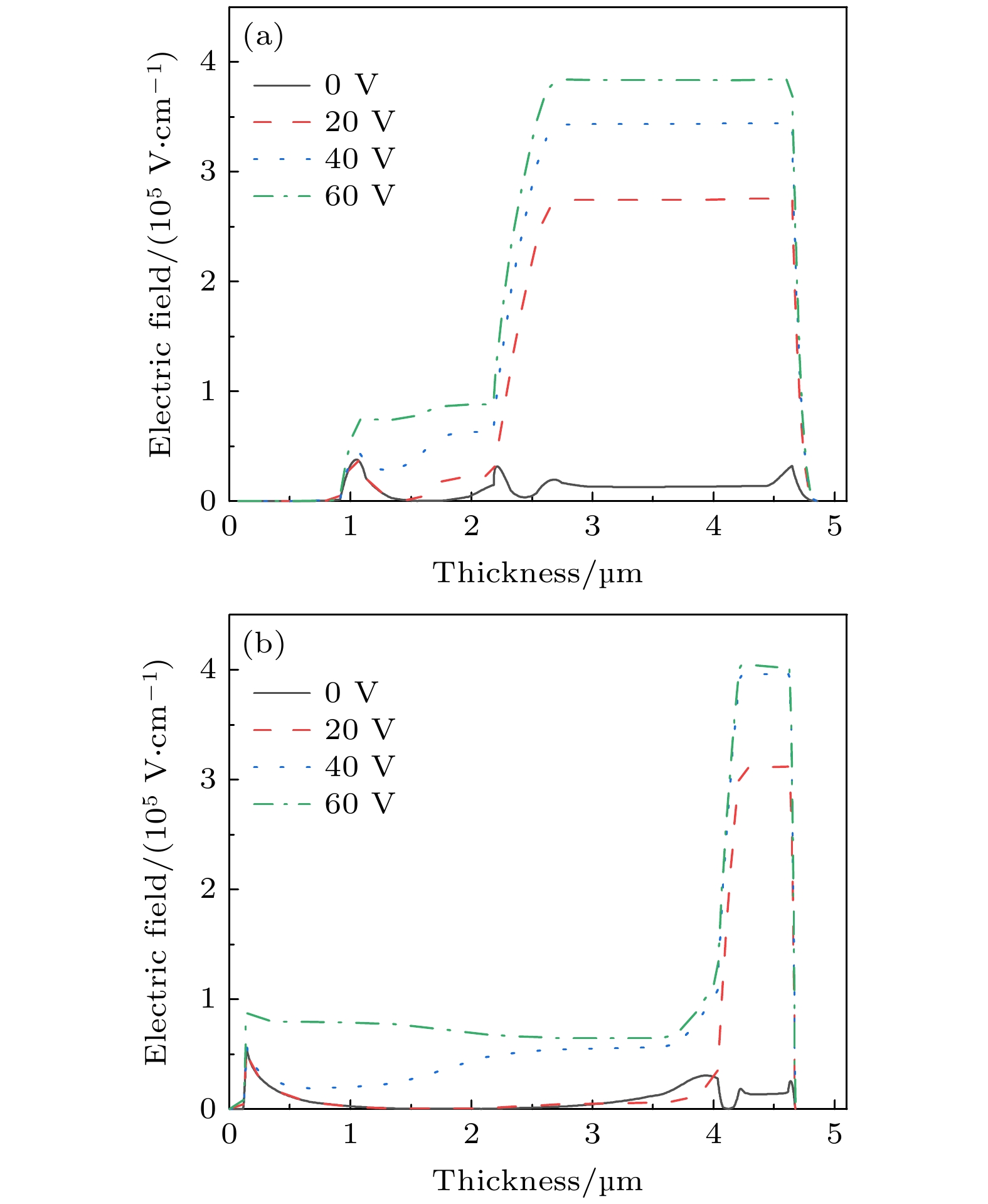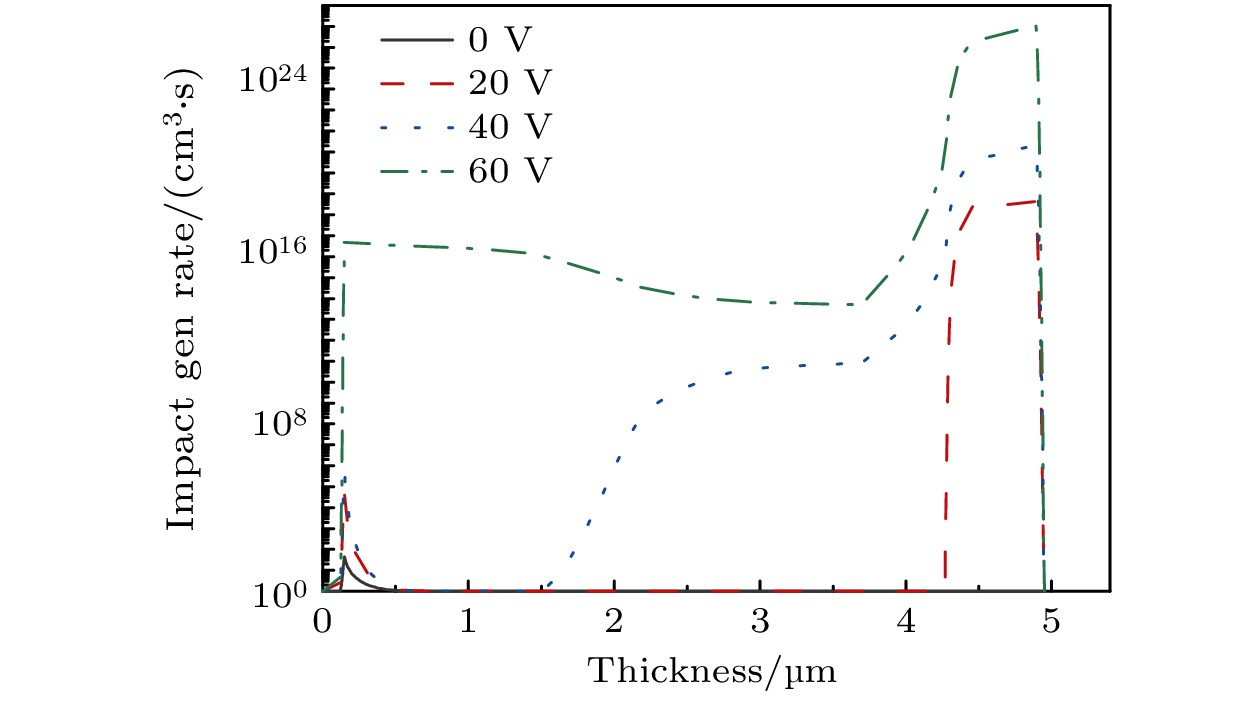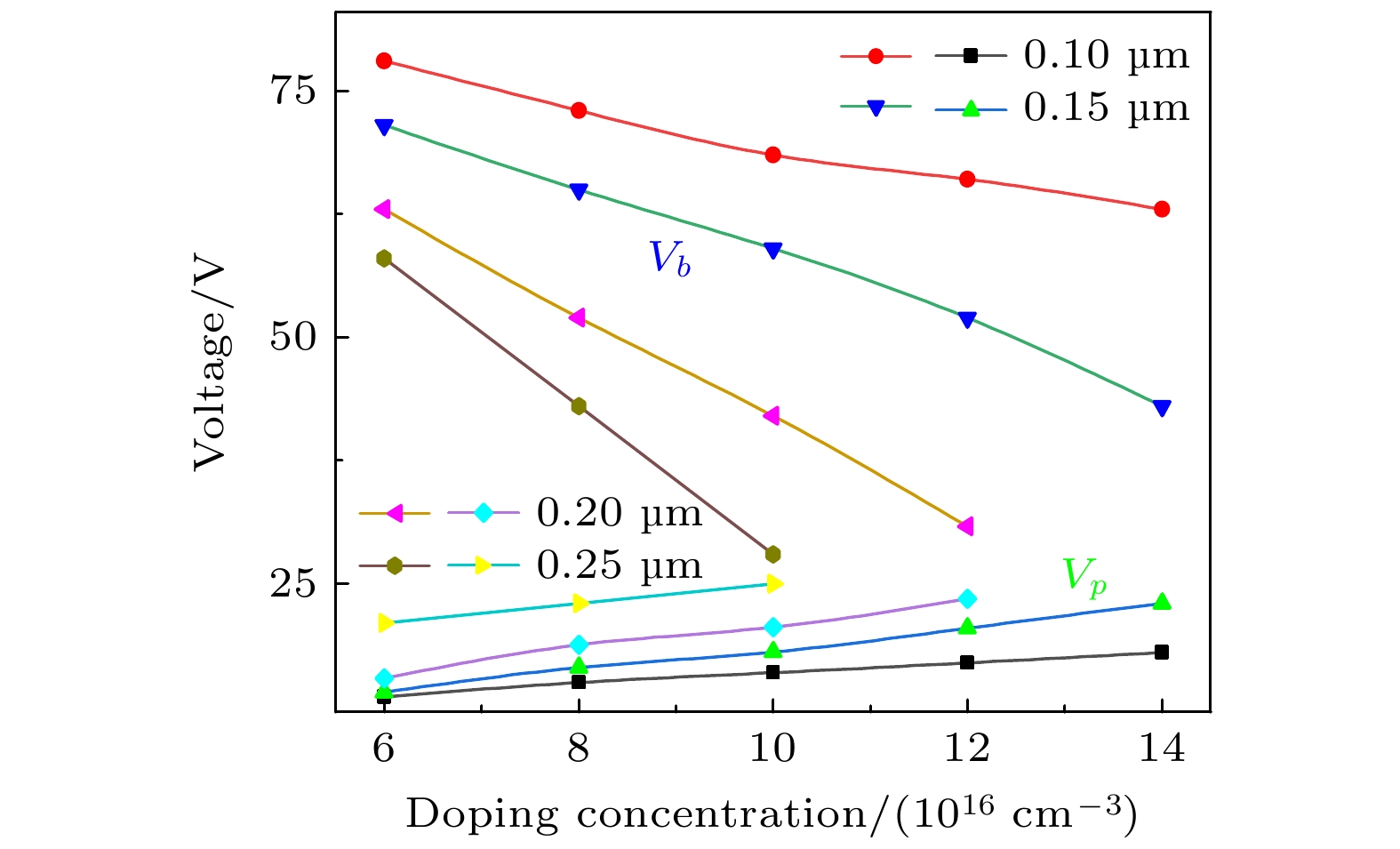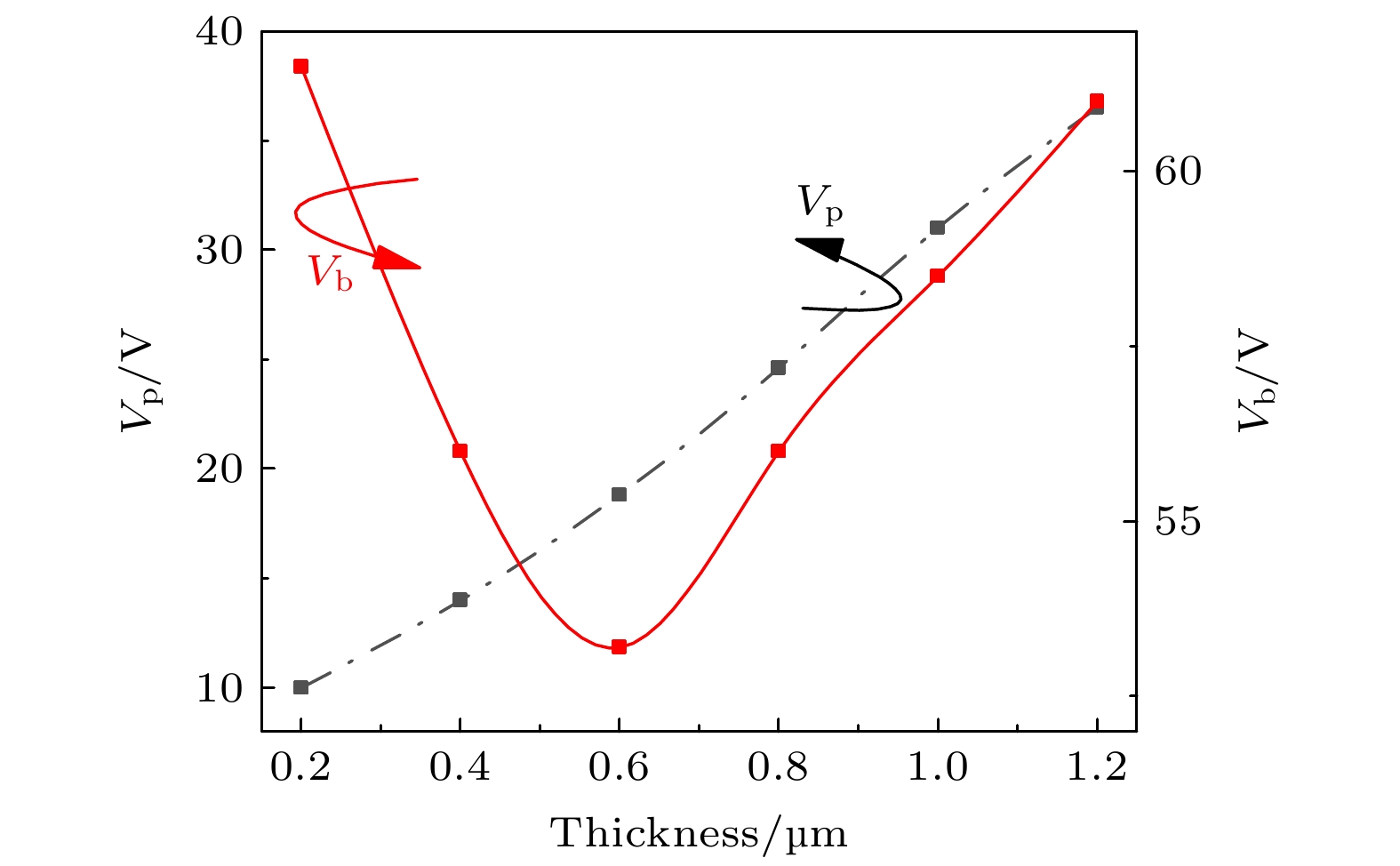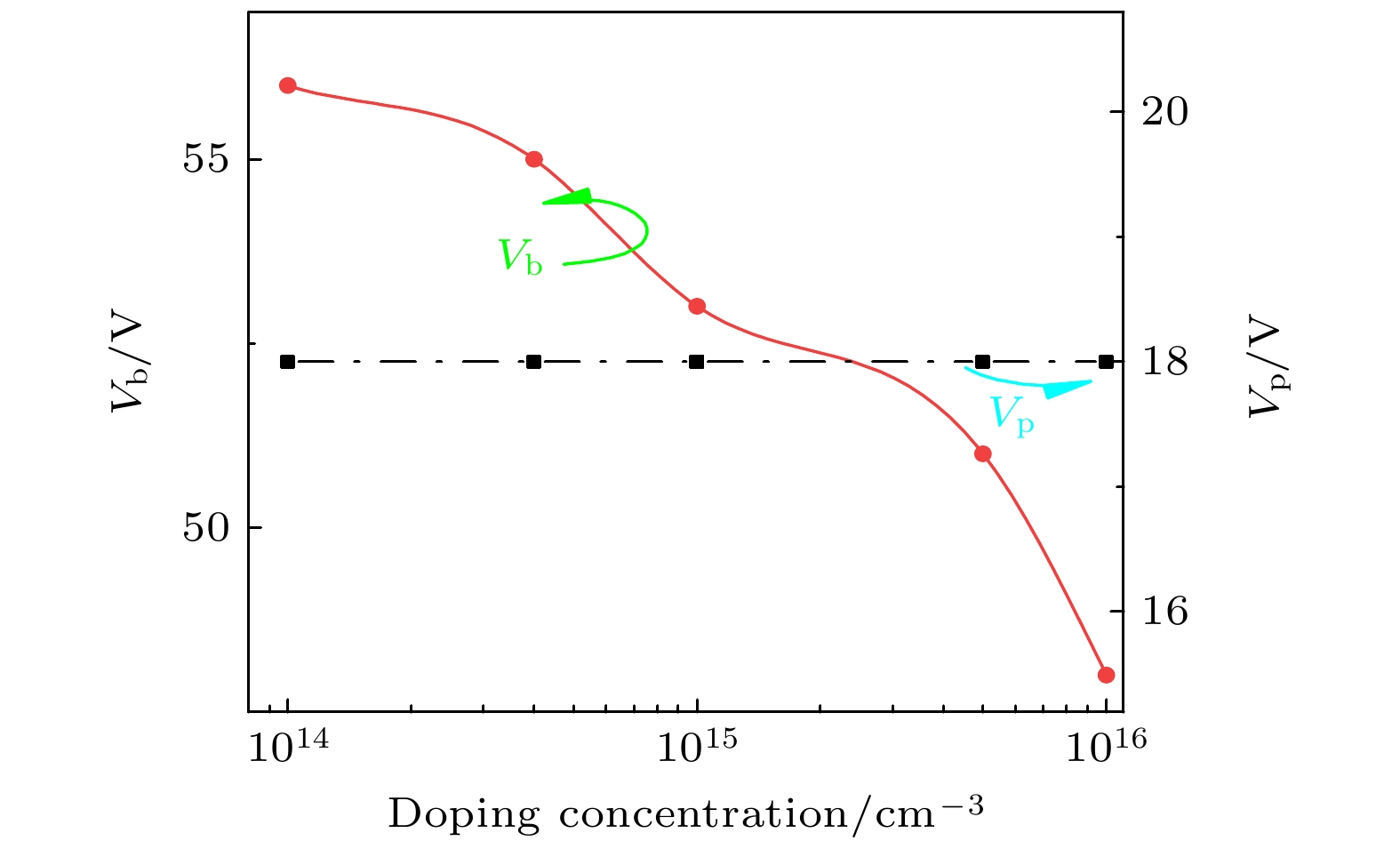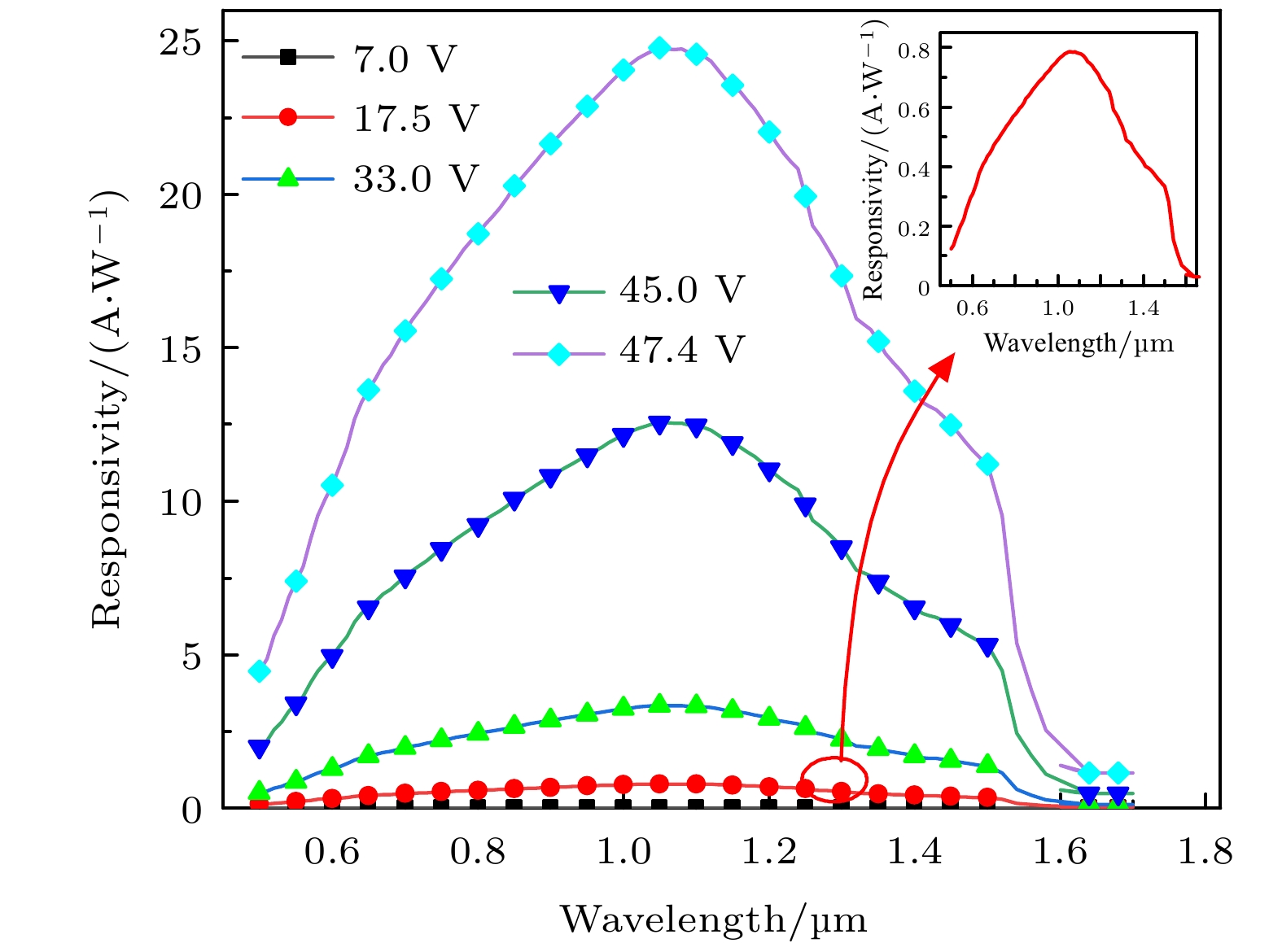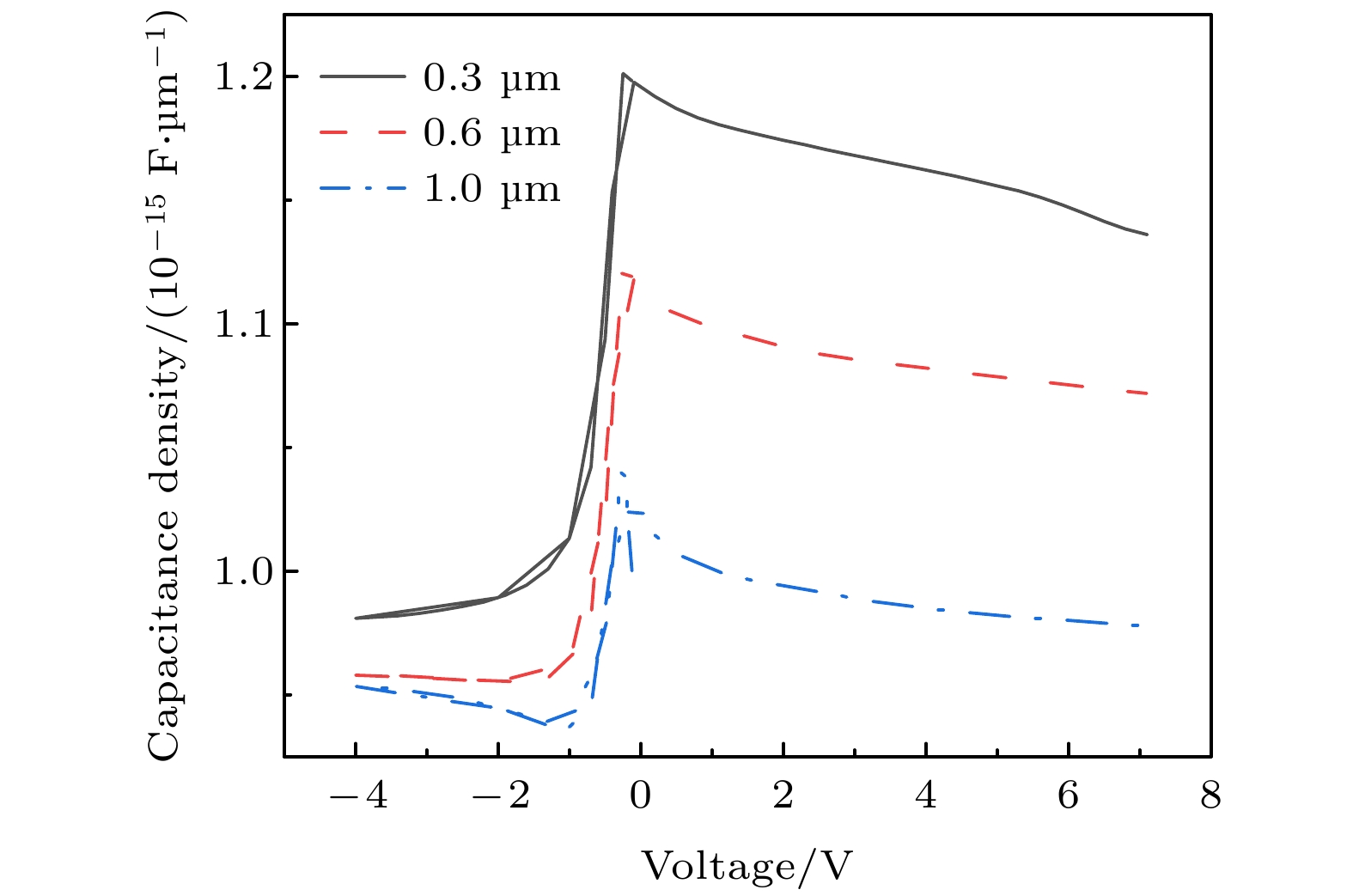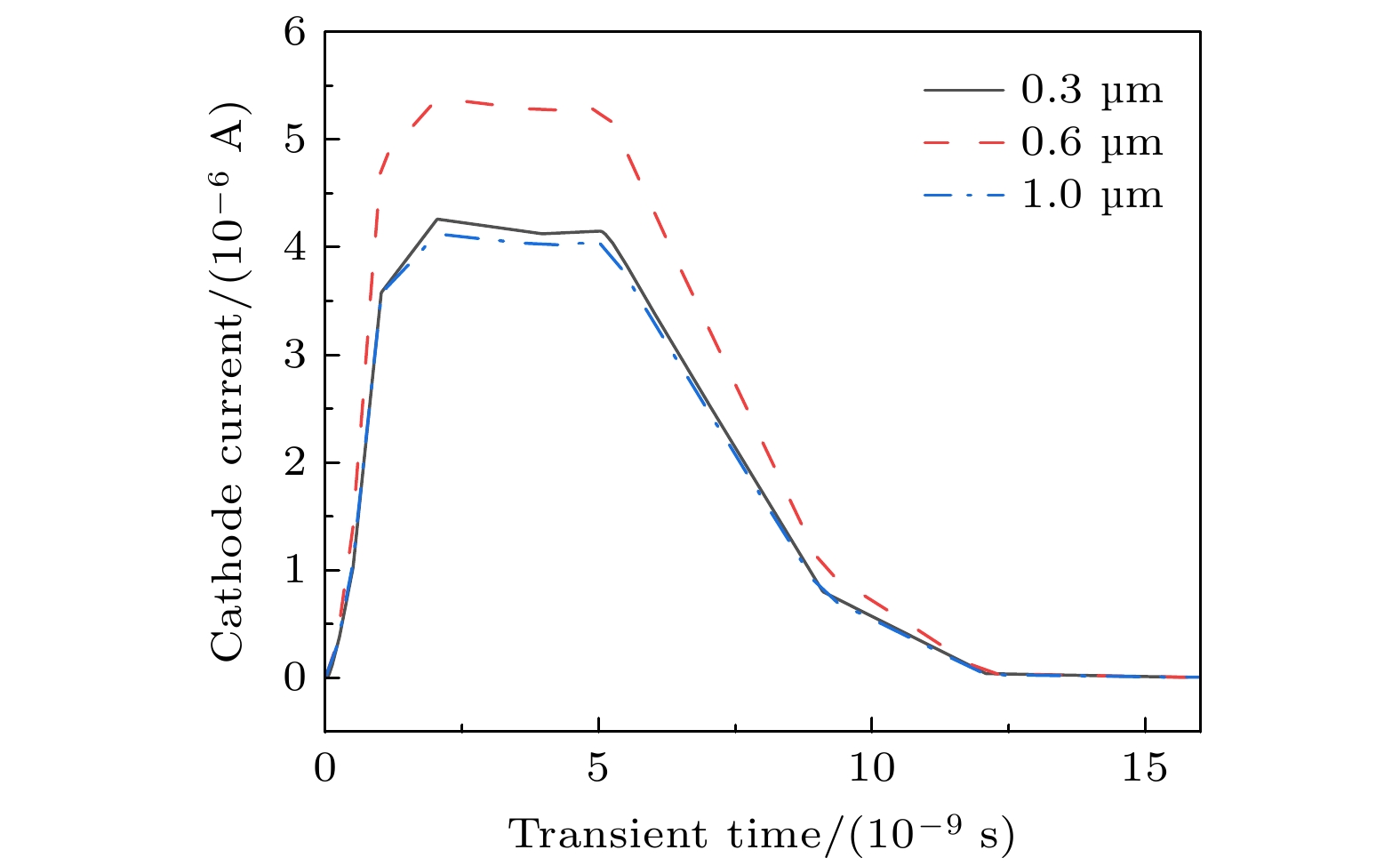-
Mg2Si作为一种天然丰富的环保材料, 在近红外波段吸收系数高, 应用于光电二极管中对替代市面上普遍使用的含有毒元素的红外探测器具有重要意义. 采用Silvaco软件中Atlas模块构建出以Mg2Si为吸收层的吸收层、电荷层和倍增层分离结构Mg2Si/Si雪崩光电二极管, 研究了电荷层和倍增层的厚度以及掺杂浓度对雪崩光电二极管的内部电场分布、穿通电压、击穿电压、C-V特性和瞬态响应的影响, 分析了偏置电压对I-V特性和光谱响应的影响, 得到了雪崩光电二极管初步优化后的穿通电压、击穿电压、暗电流密度、增益系数(Mn)和雪崩效应后对器件电流的放大倍数(M). 当入射光波长为1.31 µm, 光功率为0.01 W/cm2时, 光电二极管的穿通电压为17.5 V, 击穿电压为50 V, 在外加偏压为47.5 V (0.95倍击穿电压)下, 器件的光谱响应在波长为1.1 µm处取得峰值25 A/W, 暗电流密度约为3.6 × 10–5 A/cm2, Mn为19.6, 且Mn在器件击穿时有最大值为102, M为75.4. 根据模拟计算结果, 优化了器件结构参数, 为高性能的器件结构设计和实验制备提供理论指导.
-
关键词:
- SACM-APD /
- Mg2Si/Si异质结 /
- 光谱响应 /
- 增益系数
InGaAs and HgCdTe materials are widely used in short wave infrared photodetectors, which contain heavy metal elements. The massive use of the heavy metal elements naturally results in their scarcity, and the nonnegligible environmental pollution. Searching for other suitable materials for infrared devices becomes a key to solving the above problems. As a kind of abundant and eco-friendly material, Mg2Si has a high absorption coefficient in the near-infrared band. Its application in infrared detector makes it possible to replace the infrared devices containing toxic elements on the market in the future. The Mg2Si/Si avalanche photodiode(APD) with separation structure of absorption layer, charge layer and multiplication layer, with Mg2Si serving as the absorption layer, is constructed by using the Atlas module in Silvaco software. The effects of the thickness and doping concentration of the charge layer and multiplier layer on the distribution of internal electric field, punch-through voltage, breakdown voltage (Vb), C-V characteristics, and transient response of Mg2Si/Si SACM-APD are simulated. The effects of bias voltage on the I-V characteristics and spectral response are analyzed. The punch-through voltage, breakdown voltage, dark current density, gain coefficient (Mn) and the current amplification factor (M) after avalanche effect of APD are obtained after the structure optimization. According to the simulation results, the spectral response wavelength of the device is extended to 1.6 μm, so the selection of Mg2Si as the absorption layer effectively extends the spectral response band of Si based APD. When the wavelength of incident light is 1.31 µm and the optical power is 10 mW/cm2, the obtained punch-through voltage is 17.5 V, and the breakdown voltage is 50 V. When the bias voltage is 47.5 V (0.95Vb), the peak value of spectral response is 25 A/W at a wavelength of 1.1 μm, a density of dark current is about 3.6 × 10–5 A/cm2, a multiplication factor Mn is 19.6, and Mn achieves a maximum value of 102 when the device is broken down. Meanwhile, the current amplification factor M after avalanche effect is 75.4, and the current gain effect of the SACM structure is obvious. The peak value of spectral response for the pin-type photodiode in the previous study is only 0.742 A/W. Comparing with the pin-type photodiode, the spectral response of Mg2Si/Si SACM-APD is greatly improved. In this work, the structure parameters of the device are optimized, which lays a nice foundation for fabricating the high-performance devices.-
Keywords:
- SACM-APD /
- Mg2Si/Si heterojunction /
- spectral response /
- gain coefficient
[1] 莫秋燕, 赵彦立 2011 物理学报 60 072902
 Google Scholar
Google Scholar
Mo Q Y, Zhao Y L 2011 Acta Phys. Sin. 60 072902
 Google Scholar
Google Scholar
[2] Park S M, Grein C H 2019 J. Electron. Mater. 48 8163
 Google Scholar
Google Scholar
[3] Rogalski A 2005 Rep. Prog. Phys. 68 2267
 Google Scholar
Google Scholar
[4] Xu S J, Chua S J, Mei T, Wang X C, Zhang X H, Karunasiri G, Fan W J, Wang C H, Jiang J, Wang S, Xie X G 1998 Appl. Phys. Lett. 73 3153
 Google Scholar
Google Scholar
[5] Rogalski A 2002 Infrared. Phys. Technol. 43 187
 Google Scholar
Google Scholar
[6] Rogalski A 2011 Infrared. Phys. Technol. 54 136
 Google Scholar
Google Scholar
[7] 胡伟达, 李庆, 陈效双, 陆卫 2019 物理学报 68 120701
 Google Scholar
Google Scholar
Hu W D, Li Q, Chen X S, Lu W 2019 Acta Phys. Sin. 68 120701
 Google Scholar
Google Scholar
[8] LaBotz R 1963 J. Electrochem. Soc. 110 127
 Google Scholar
Google Scholar
[9] Kato T, Sago Y, Fujiwara H 2011 J. Appl. Phys. 110 063723
 Google Scholar
Google Scholar
[10] Borisenko V E 2000 Semiconducting Silicides (New York: Springer) pp137−179
[11] Au-Yang M Y, Cohen M L 1969 Phys. Rev. 178 1358
 Google Scholar
Google Scholar
[12] Liao Y F, Fan M H, Xie Q, Xiao Q Q, Xie J, Yu H, Wang S L, Ma X Y 2018 Appl. Surf. Sci. 403 302
 Google Scholar
Google Scholar
[13] Janega P L, McCaffrey J, Landheer D, Buchanan M, Denhoff M, Mitchel D 1988 Appl. Phys. Lett. 53 2056
 Google Scholar
Google Scholar
[14] Udono H, Tajima H, Uchikoshi M, Itakura M 2015 Jpn. J. Appl. Phys. 54 07JB06
 Google Scholar
Google Scholar
[15] Udono H, Yamanaka Y, Uchikoshi M, Isshiki M 2013 J. Phys. Chem. Solids. 74 311
 Google Scholar
Google Scholar
[16] El-Amir A A M, Ohsawa T, Nabatame T, Ohia A, Wadaa Y, Nakamuraa M, Fua K, Shimamuraa K, Ohashia N 2019 Mater. Sci. Semicond. Process. 91 222
 Google Scholar
Google Scholar
[17] 陈豪, 肖清泉, 谢泉, 王坤, 史娇娜 2019 材料导报 33 3358
 Google Scholar
Google Scholar
Chen H, Xiao Q Q, Xie Q, Wang K, Shi J N, 2019 Mater. Rep. 33 3358
 Google Scholar
Google Scholar
[18] Forrest S R, Kim O K, Smith R G 1982 Appl. Phys. Lett. 41 95
 Google Scholar
Google Scholar
[19] 张海燕, 汪琳莉, 吴琛怡, 王煜蓉, 杨雷, 潘海峰, 刘巧莉, 郭霞, 汤凯, 张忠萍, 吴光 2020 物理学报 69 074204
 Google Scholar
Google Scholar
Zhang H Y, Wang L L, Wu C Y, Wang Y R, Yang L, Pang H F, Liu Q L, Guo X, Tang K, Zhang Z P, Wu G 2020 Acta Phys. Sin. 69 074204
 Google Scholar
Google Scholar
[20] Nishida K, Taguchi K, Matsumoto Y 1979 Appl. Phys. Lett. 35 251
 Google Scholar
Google Scholar
[21] Deng Q, Wang Z, Wang S, Shao G D 2017 Sol. Energy 158 654
 Google Scholar
Google Scholar
[22] Sekino K, Midonoya M, Udono H, Yamada Y Udono H 2011 Phys. Procedia 11 171
 Google Scholar
Google Scholar
[23] Martin A G 2008 Sol. Energy Mater. Sol. Cells 92 1305
 Google Scholar
Google Scholar
[24] Park C Y, Hyun K, Kang S G, Kim H M 1995 Appl. Phys. Lett. 67 3789
 Google Scholar
Google Scholar
[25] Smetona S, Matukas J, Palenskis V, Olechnovicius M, A. Kaminskas K, Mallard R 2004 Proceedings of SPIE-Photonics North 2004: Optical Components and Devices Ottawa, Canada, September 26–29, 2004 p834
[26] 谢天, 叶新辉, 夏辉, 李菊柱, 张帅君, 姜新洋, 邓伟杰, 王文静, 李玉莹, 刘伟伟, 李翔, 李天信 2020 红外与毫米波学报 39 0583
 Google Scholar
Google Scholar
Xie T, Ye X H, Xia H, Li J Z, Zhang S J, Jiang X Y, Deng W J, Wang W J, Li Y Y, Liu W W, Li X, Li T X 2020 J. Infrared Millim. W. 39 0583
 Google Scholar
Google Scholar
[27] Yuan H, Zhang J, Kim J, Meyer C, Laquindanum J, Kimchi J, Lei J 2018 Proceedings of SPIE -Infrared Sensors, Devices, and Applications VIII San Diego, United States, August 22–23, 2018 p107660 J-1
[28] Wang Y D, Chen J, Xu J D, Li X Y 2018 Infrared Phys. Technol. 89 41
 Google Scholar
Google Scholar
[29] 施敏, 伍国珏 著 (耿莉, 张瑞智 译) 2008 半导体器件物理 (第3版) (西安: 西安交通大学出版社) 第514−523页
Sze S M, K. Ng K (translated by Geng L, Wu G J) 2008 Physics of Semiconductor Devices (3rd Ed.) (Xi’an: Xi’an Jiaotong University Press) pp514−523 (in Chinese)
[30] Lee M J, Rucker H, Choi W Y 2012 IEEE Electron Device Lett. 33 80
 Google Scholar
Google Scholar
-
表 1 APD的结构参数
Table 1. Structural parameters of the APD.
层名 符号 厚度/μm 符号 浓度掺杂/
× 1016 cm–3金属电极层 — 0.1 — 0 Mg2Si接触层 Wp 0.15 Np 500 Mg2Si吸收层 Wa 0.6—4 Na 0.1 Si电荷层 Wc 0.1—0.3 Nc 6—14 Si倍增层 Wm 1 Nm 0.01—1 Si缓冲层 Wb 0.5 Nb 100 Si衬底 Ws 3.5 Ns 1000 表 2 模拟计算中采用的各层基本参数
Table 2. The parameters of different layers in the simulation.
表 3 模拟结果与目前国际水平对比
Table 3. Comparison of simulation results with current international level.
-
[1] 莫秋燕, 赵彦立 2011 物理学报 60 072902
 Google Scholar
Google Scholar
Mo Q Y, Zhao Y L 2011 Acta Phys. Sin. 60 072902
 Google Scholar
Google Scholar
[2] Park S M, Grein C H 2019 J. Electron. Mater. 48 8163
 Google Scholar
Google Scholar
[3] Rogalski A 2005 Rep. Prog. Phys. 68 2267
 Google Scholar
Google Scholar
[4] Xu S J, Chua S J, Mei T, Wang X C, Zhang X H, Karunasiri G, Fan W J, Wang C H, Jiang J, Wang S, Xie X G 1998 Appl. Phys. Lett. 73 3153
 Google Scholar
Google Scholar
[5] Rogalski A 2002 Infrared. Phys. Technol. 43 187
 Google Scholar
Google Scholar
[6] Rogalski A 2011 Infrared. Phys. Technol. 54 136
 Google Scholar
Google Scholar
[7] 胡伟达, 李庆, 陈效双, 陆卫 2019 物理学报 68 120701
 Google Scholar
Google Scholar
Hu W D, Li Q, Chen X S, Lu W 2019 Acta Phys. Sin. 68 120701
 Google Scholar
Google Scholar
[8] LaBotz R 1963 J. Electrochem. Soc. 110 127
 Google Scholar
Google Scholar
[9] Kato T, Sago Y, Fujiwara H 2011 J. Appl. Phys. 110 063723
 Google Scholar
Google Scholar
[10] Borisenko V E 2000 Semiconducting Silicides (New York: Springer) pp137−179
[11] Au-Yang M Y, Cohen M L 1969 Phys. Rev. 178 1358
 Google Scholar
Google Scholar
[12] Liao Y F, Fan M H, Xie Q, Xiao Q Q, Xie J, Yu H, Wang S L, Ma X Y 2018 Appl. Surf. Sci. 403 302
 Google Scholar
Google Scholar
[13] Janega P L, McCaffrey J, Landheer D, Buchanan M, Denhoff M, Mitchel D 1988 Appl. Phys. Lett. 53 2056
 Google Scholar
Google Scholar
[14] Udono H, Tajima H, Uchikoshi M, Itakura M 2015 Jpn. J. Appl. Phys. 54 07JB06
 Google Scholar
Google Scholar
[15] Udono H, Yamanaka Y, Uchikoshi M, Isshiki M 2013 J. Phys. Chem. Solids. 74 311
 Google Scholar
Google Scholar
[16] El-Amir A A M, Ohsawa T, Nabatame T, Ohia A, Wadaa Y, Nakamuraa M, Fua K, Shimamuraa K, Ohashia N 2019 Mater. Sci. Semicond. Process. 91 222
 Google Scholar
Google Scholar
[17] 陈豪, 肖清泉, 谢泉, 王坤, 史娇娜 2019 材料导报 33 3358
 Google Scholar
Google Scholar
Chen H, Xiao Q Q, Xie Q, Wang K, Shi J N, 2019 Mater. Rep. 33 3358
 Google Scholar
Google Scholar
[18] Forrest S R, Kim O K, Smith R G 1982 Appl. Phys. Lett. 41 95
 Google Scholar
Google Scholar
[19] 张海燕, 汪琳莉, 吴琛怡, 王煜蓉, 杨雷, 潘海峰, 刘巧莉, 郭霞, 汤凯, 张忠萍, 吴光 2020 物理学报 69 074204
 Google Scholar
Google Scholar
Zhang H Y, Wang L L, Wu C Y, Wang Y R, Yang L, Pang H F, Liu Q L, Guo X, Tang K, Zhang Z P, Wu G 2020 Acta Phys. Sin. 69 074204
 Google Scholar
Google Scholar
[20] Nishida K, Taguchi K, Matsumoto Y 1979 Appl. Phys. Lett. 35 251
 Google Scholar
Google Scholar
[21] Deng Q, Wang Z, Wang S, Shao G D 2017 Sol. Energy 158 654
 Google Scholar
Google Scholar
[22] Sekino K, Midonoya M, Udono H, Yamada Y Udono H 2011 Phys. Procedia 11 171
 Google Scholar
Google Scholar
[23] Martin A G 2008 Sol. Energy Mater. Sol. Cells 92 1305
 Google Scholar
Google Scholar
[24] Park C Y, Hyun K, Kang S G, Kim H M 1995 Appl. Phys. Lett. 67 3789
 Google Scholar
Google Scholar
[25] Smetona S, Matukas J, Palenskis V, Olechnovicius M, A. Kaminskas K, Mallard R 2004 Proceedings of SPIE-Photonics North 2004: Optical Components and Devices Ottawa, Canada, September 26–29, 2004 p834
[26] 谢天, 叶新辉, 夏辉, 李菊柱, 张帅君, 姜新洋, 邓伟杰, 王文静, 李玉莹, 刘伟伟, 李翔, 李天信 2020 红外与毫米波学报 39 0583
 Google Scholar
Google Scholar
Xie T, Ye X H, Xia H, Li J Z, Zhang S J, Jiang X Y, Deng W J, Wang W J, Li Y Y, Liu W W, Li X, Li T X 2020 J. Infrared Millim. W. 39 0583
 Google Scholar
Google Scholar
[27] Yuan H, Zhang J, Kim J, Meyer C, Laquindanum J, Kimchi J, Lei J 2018 Proceedings of SPIE -Infrared Sensors, Devices, and Applications VIII San Diego, United States, August 22–23, 2018 p107660 J-1
[28] Wang Y D, Chen J, Xu J D, Li X Y 2018 Infrared Phys. Technol. 89 41
 Google Scholar
Google Scholar
[29] 施敏, 伍国珏 著 (耿莉, 张瑞智 译) 2008 半导体器件物理 (第3版) (西安: 西安交通大学出版社) 第514−523页
Sze S M, K. Ng K (translated by Geng L, Wu G J) 2008 Physics of Semiconductor Devices (3rd Ed.) (Xi’an: Xi’an Jiaotong University Press) pp514−523 (in Chinese)
[30] Lee M J, Rucker H, Choi W Y 2012 IEEE Electron Device Lett. 33 80
 Google Scholar
Google Scholar
计量
- 文章访问数: 11629
- PDF下载量: 200
- 被引次数: 0













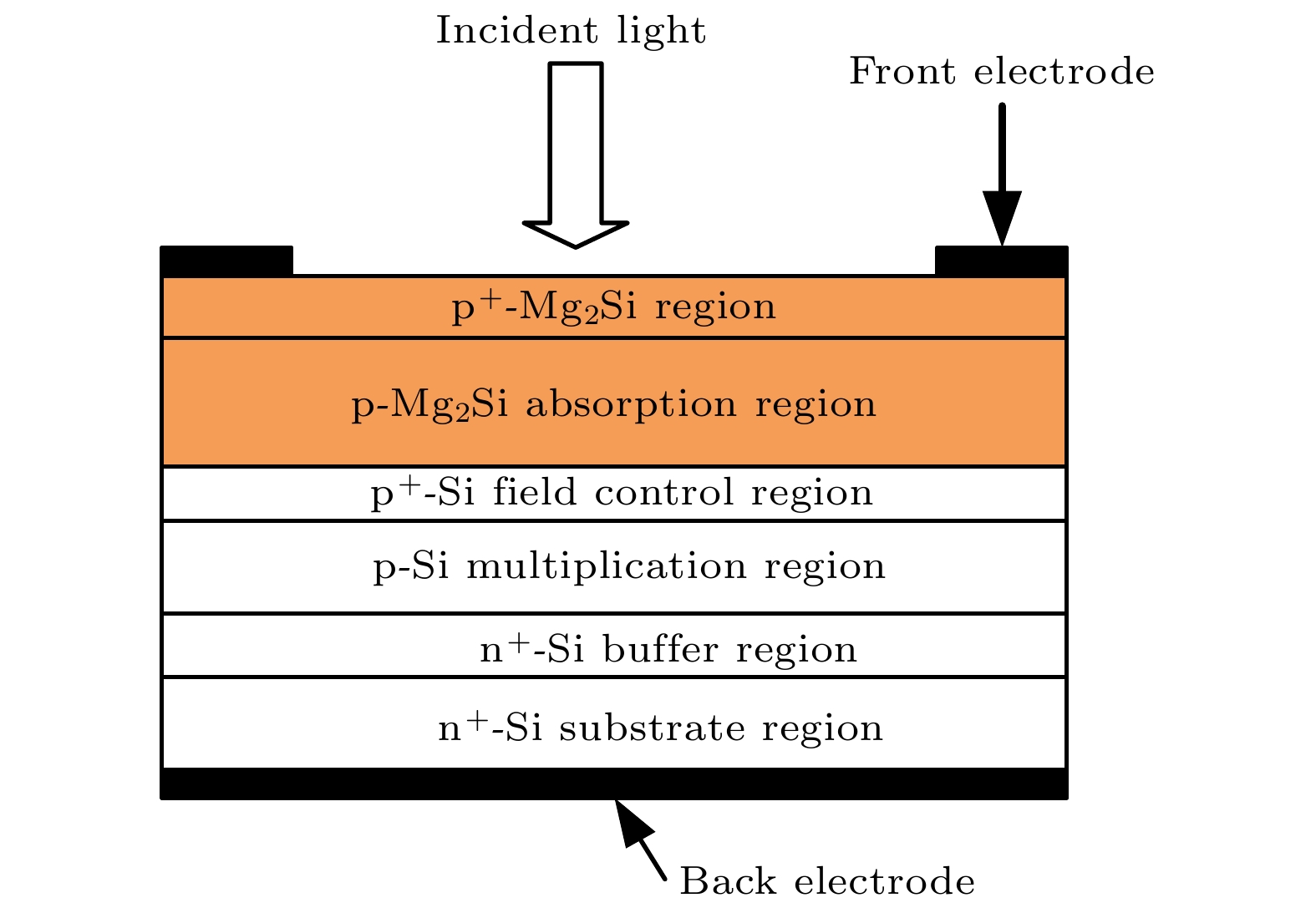
 下载:
下载:
